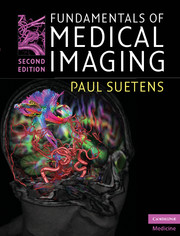Book contents
- Frontmatter
- Contents
- Preface
- Acknowledgments
- 1 Introduction to digital image processing
- 2 Radiography
- 3 X-ray computed tomography
- 4 Magnetic resonance imaging
- 5 Nuclear medicine imaging
- 6 Ultrasound imaging
- 7 Medical image analysis
- 8 Visualization for diagnosis and therapy
- Appendix A Linear system theory
- Appendix B Exercises
- Bibliography
- Index
8 - Visualization for diagnosis and therapy
Published online by Cambridge University Press: 30 September 2009
- Frontmatter
- Contents
- Preface
- Acknowledgments
- 1 Introduction to digital image processing
- 2 Radiography
- 3 X-ray computed tomography
- 4 Magnetic resonance imaging
- 5 Nuclear medicine imaging
- 6 Ultrasound imaging
- 7 Medical image analysis
- 8 Visualization for diagnosis and therapy
- Appendix A Linear system theory
- Appendix B Exercises
- Bibliography
- Index
Summary
Introduction
Medical images are typically generated as 2D projection images or sequences, as in radiography, or as stacks of 2D image slices, as in tomographic imaging. To use them for diagnostic or interventional purposes, the image data can be visualized as such, but they can also be shown as resliced images or as three dimensional (3D) images. This chapter discusses the clinically relevant visualization methods.
Medical images are used not only for diagnostic purposes, but also often serve as the basis for a therapeutic or surgical intervention during which the instruments are guided by and navigate through the image content. Images can be obtained prior to and during surgery. Preoperative images, such as CT, MRI, and PET, can be used for accurate planning and can be acquired with the available diagnostic imaging modalities. However, the planning has to be accurately applied to the patient in the operating room. This requires a method to register geometrically the preoperative images and planning data with the surgical instruments. A computer can assist in both this planning and the registration, a process known as computer assisted intervention.
To plan or simulate an intervention, preoperative images are imported in a 3D graphics computer workstation and manipulated as real 3D volumes. Planning is surgery specific and typically consists of defining linear or curved trajectories to access a lesion, to position an implant, to simulate ablations and resections, or to reposition resected tissue.
Stereotactic brain surgery played a pioneering role in the development of computer assisted interventions.
- Type
- Chapter
- Information
- Fundamentals of Medical Imaging , pp. 190 - 218Publisher: Cambridge University PressPrint publication year: 2009



